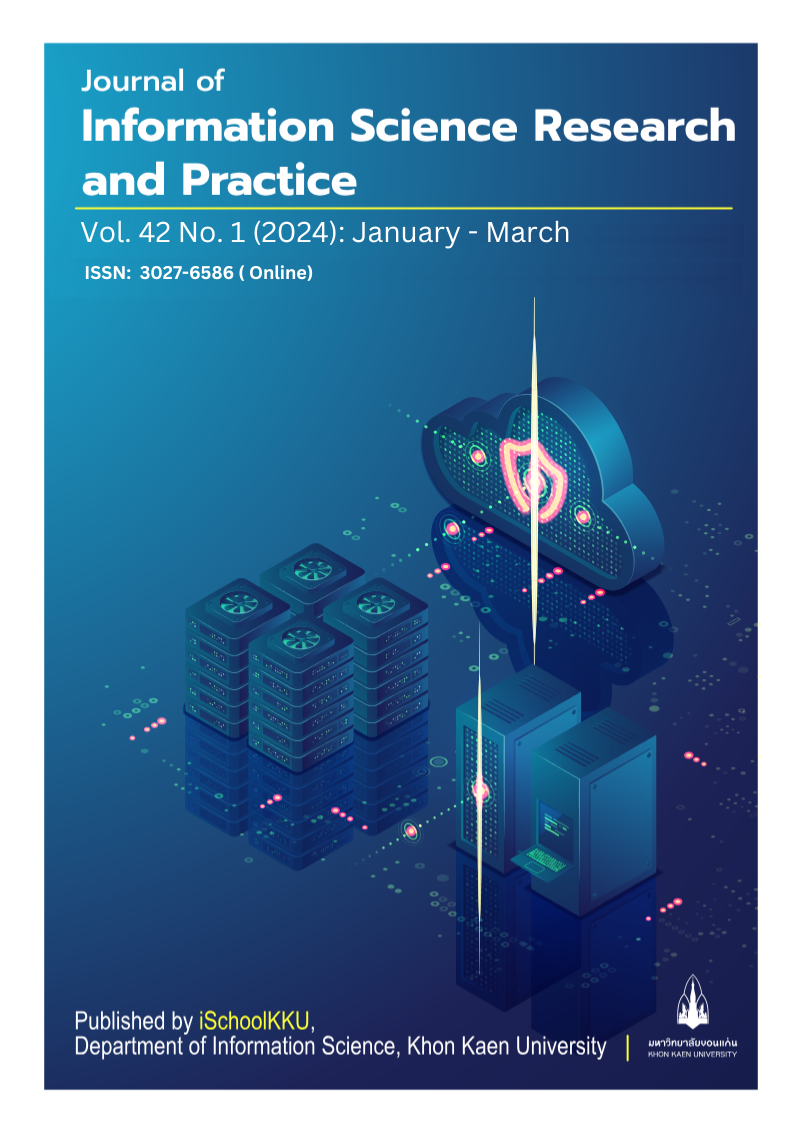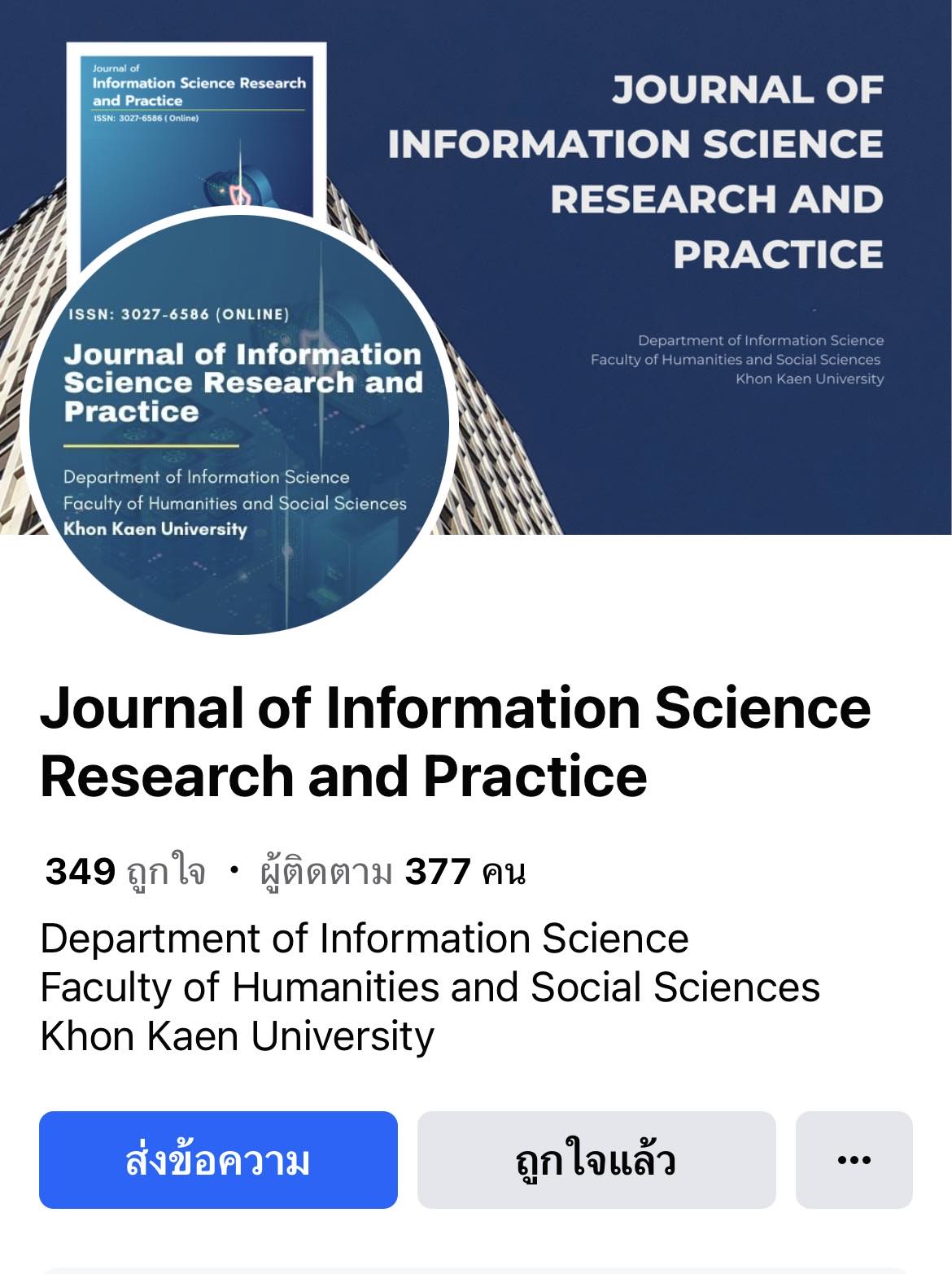Exploring Technology Acceptance through Social Media Listening: An Investigation of ChatGPT Utilization
DOI:
https://doi.org/10.14456/jiskku.2024.4Keywords:
Information on Social Media, Technology Acceptance, Chat GPTAbstract
Purpose: The objective of this study is to investigate online conversation and conduct sentiment analysis regarding ChatGPT within the framework of the overarching Theory of Acceptance and Use of Technology.
Methodology: Data collection was conducted using a Social Listening tool on online platforms, specifically Facebook and Twitter, from December 4, 2022, to April 4, 2023, resulting in a total of 1,147 entries. Subsequently, content analysis was performed utilizing a coding frame developed through a concept-driven coding approach.
Findings: When studying conversations related to ChatGPT on Facebook and Twitter, the most prevalent theme was the perception of performance expectations, followed by risk perception, perceived effort expectation, perceived credibility, perceived price, perceived social influencer, and perceived self-efficacy in descending order. As for the sentiment analysis, the findings indicate that the highest occurrence of positively expressed comments was associated with the dimension of perceived performance expectations in the effectiveness of Chat GPT.
Applications of this study: Guidelines for studying with data from online social media and relevant organizations involved in disseminating information on social media have directions for promoting the use of data innovation for greater acceptable.
Downloads
References
Agrawal, A., Gans, J., & Goldfarb, A. (2022). ChatGPT and How AI disrupts industries. Retrieved from https://hbr.org/2022/12/chatgpt-and-how-ai-disrupts-industries
Alnoor, A. M. R., Al-Abrrow, H., Abdullah, H., & Abbas, S. (2019). The impact of self-efficacy on employees’ ability to accept new technology in an Iraqi university. Global Business and Organizational Excellence, 39(2), 41–50. https://doi.org/10.1002/joe.21984
Al-Saedi, K., Al-Emran, M., Ramayah, T., & Abusham, E. (2020). Developing a general extended UTAUT model for M-payment adoption. Technology in Society, 62, 101293. https://doi.org/10.1016/j.techsoc.2020.101293
Ambawat, M., & Wadera, D. D. (2019). A review of chatbots adoption from the consumers perspectives. Journal of the Gujarat Research Society, 21(11), 135–145.
Ashfaq, M., Yun, J., Yu, S., & Loureiro, S. M. C. (2020). I, Chatbot: Modeling the determinants of users’ satisfaction and continuance intention of AI-powered service agents. Telematics and Informatics, 54, 101473. https://doi.org/10.1016/j.tele.2020.101473
Balakrishnan, J., Abed, S. S., & Jones, P. (2022). The role of meta-UTAUT factors, perceived anthropomorphism, perceived intelligence, and social self-efficacy in chatbot-based services? Technological Forecasting and Social Change, 180, 121692. https://doi.org/10.1016/j.techfore.2022.121692
Balapour, A., Reychav, I., Sabherwal, R., & Azuri, J. (2019). Mobile technology identity and self-efficacy: Implications for the adoption of clinically supported mobile health apps. International Journal of Information Management, 49, 58–68. https://doi.org/10.1016/j.ijinfomgt.2019.03.005
Baruffati, A. (2023). Chat GPT Statistics 2023: Trends and the future perspectives. Retrieved from https://blog.gitnux.com/chat-gpt-statistics/
Biswas, S. S. (2023). Role of chat GPT in public health. Annals of Biomedical Engineering, 51(5). https://doi.org/10.1007/s10439-023-03172-7
Bouvier, G., & Rasmussen, J. (2022). Qualitative research using social media. Routledge.
Carleton, E. L., Barling, J., & Trivisonno, M. (2018). Leaders’ trait mindfulness and transformational leadership: The mediating roles of leaders’ positive affect and leadership self-efficacy. Canadian Journal of Behavioural Science/Revue Canadienne Des Sciences Du Comportement, 50(3), 185–194. https://doi.org/10.1037/cbs0000103
Choudhury, A., & Shamszare, H. (2023). Investigating the impact of user trust on the adoption and use of chatgpt: survey analysis. Journal of Medical Internet Research, 25(1), e47184. https://doi.org/10.2196/47184
Csutoras, B. (2022). The future of chatbots: use cases & opportunities you need to know. Retrieved from https://www.searchenginejournal.com/future-of-chatbots/278595/#close
Eloundou, T., Manning, S., Mishkin, P., & Rock, D. (2023). GPTs are GPTs: An early look at the labor market impact potential of large language models. ArXiv (Cornell University). https://doi.org/10.48550/arxiv.2303.10130
Eren, B. A. (2021). Determinants of customer satisfaction in chatbot use: evidence from a banking application in Turkey. International Journal of Bank Marketing, 39(2), 294–311. https://doi.org/10.1108/ijbm-02-2020-0056
Gansser, O. A., & Reich, C. S. (2021). A new acceptance model for artificial intelligence with extensions to UTAUT2: An empirical study in three segments of application. Technology in Society, 65, 101535. https://doi.org/10.1016/j.techsoc.2021.101535
Gartner. (2018). Gartner identifies five emerging technology trends that will blur the lines between human and machine. Retrieved from https://www.gartner.com/en/newsroom/press-releases/2018-08-20-gartner-identifies-five-emerging-technology-trends-that-will-blur-the-lines-between-human-and-machine
Gitnux. (2023). Dependence On Technology 2023: Key Insights and Trends. Retrieved from https://blog.gitnux.com/dependence-on-technology-statistics/
Gronmo, S. (2019). Social research methods: qualitative, quantitative and mixed methods approaches. S.L.: Sage Publications.
Howard, A., Hope, W., & Gerada, A. (2023). ChatGPT and antimicrobial advice: the end of the consulting infection doctor? The Lancet Infectious Diseases, 23(4), 405–406. https://doi.org/10.1016/s1473-3099(23)00113-5
Hughes-Castleberry, K. (2022). An increase in technology dependence may be natural, says a tech expert. Retrieved from https://thedebrief.org/an-increase-in-technology-dependence-may-be-natural-says-a-tech-expert/
Joshi, H. (2021). Perception and adoption of customer service chatbots among millennials: an empirical validation in the indian context. Proceedings of the 17th International Conference on Web Information Systems and Technologies. https://doi.org/10.5220/0010718400003058
Kamal, S. A., Shafiq, M., & Kakria, P. (2020). Investigating acceptance of telemedicine services through an extended technology acceptance model (TAM). Technology in Society, 60(1), 101212. https://doi.org/10.1016/j.techsoc.2019.101212
Menon, D., & K Shilpa. (2023). “Chatting with ChatGPT”: Analyzing the factors influencing users’ intention to Use the Open AI’s ChatGPT using the UTAUT model. Heliyon, 9(11), e20962–e20962. https://doi.org/10.1016/j.heliyon.2023.e20962
Mer, A., & Virdi, A. S. (2022). Artificial intelligence disruption on the brink of revolutionizing hr and marketing functions. Impact of Artificial Intelligence on Organizational Transformation, 1–19. https://doi.org/10.1002/9781119710301.ch1
Mishra, A., & Awasthi, S. (2023). Chat GPT: Revolutionizing communication or threatening authenticity? Management Dynamics, 23(1), 165–168. https://doi.org/10.57198/2583-4932.1321
Nguyen, D. M., Chiu, Y.-T. H., & Le, H. D. (2021). Determinants of continuance intention towards banks’ chatbot services in Vietnam: A necessity for sustainable development. Sustainability, 13(14), 7625. https://doi.org/10.3390/su13147625
Park, E. (2020). User acceptance of smart wearable devices: An expectation-confirmation model approach. Telematics and Informatics, 47, 101318. https://doi.org/10.1016/j.tele.2019.101318
Paul, J., Ueno, A., & Dennis, C. (2023). ChatGPT and consumers: Benefits, pitfalls and future research agenda. International Journal of Consumer Studies, 47(4). https://doi.org/10.1111/ijcs.12928
Ruths, D., & Pfeffer, J. (2014). Social media for large studies of behavior. Science, 346(6213), 1063–1064. https://doi.org/10.1126/science.346.6213.1063
Santandreu-Calonge, D., Medina-Aguerrebere, P., Hultberg, P., & Shah, M.-A. (2023). Can ChatGPT improve communication in hospitals? El Profesional de La Información, 32(2). https://doi.org/10.3145/epi.2023.mar.19
Shrivastava, M., & Kumar, D. (2022). The potential of artificial intelligence in public healthcare industry. Impact of Artificial Intelligence on Organizational Transformation, 349–360. https://doi.org/10.1002/9781119710301.ch20
Strzelecki, A. (2023). To use or not to use ChatGPT in higher education? A study of students’ acceptance and use of technology. Interactive Learning Environments, 1–14. https://doi.org/10.1080/10494820.2023.2209881
Subanjui, R., & Pansantia, C. (2021). Structural equation model of factors affecting the digital transformation of industrial business in rayong province. Journal of Information Science, 40(2), 23–40. https://doi.org/10.14456/jiskku.2022.9
Surameery, N. M. S., & Shakor, M. Y. (2023). Use chat gpt to solve programming bugs. International Journal of Information Technology and Computer Engineering, 3(31), 17–22. https://doi.org/10.55529/ijitc.31.17.22
Thorp, H. H. (2023). ChatGPT is fun, but not an author. Science, 379(6630), 313–313. https://doi.org/10.1126/science.adg7879
Venkatesh, V., Morris, M. G., Davis, G. B., & Davis, F. D. (2003). User acceptance of information technology: Toward a unified view. MIS Quarterly, 27(3), 425–478. JStor. https://doi.org/10.2307/30036540
Walker, J. (2018). Chatbot Comparison – Facebook, Microsoft, Amazon, and Google. Retrieved from https://www.techemergence.com/chatbot-comparison-facebook-microsoft-amazon-google/
Wang, F.-Y., Miao, Q., Li, X., Wang, X., & Lin, Y. (2023). What does ChatGPT say: The DAO from algorithmic intelligence to linguistic intelligence. IEEE/CAA Journal of Automatica Sinica, 10(3), 575–579. https://doi.org/10.1109/JAS.2023.123486








